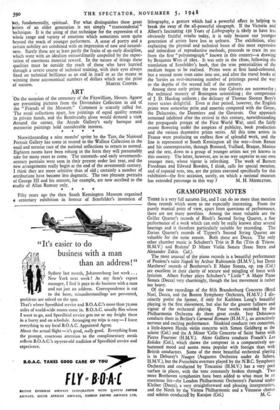ON the occasion of the centenary of the Fitzwilliam, Messrs.
Agnew are presenting pictures from the Devonshire Collection in aid of the " Friends of the Museum." Comment is scarcely called for. The royal collections apart, few paintings of equal quality remain in private hands, and the Rembrandts alone would demand a visit. Around the corner, the Arcade Gallery's early baroque and mannerist paintings hold considerable interest.
* * * re *
Notwithstanding a nine months' sprint by the Tate, the National Portrait Gallery has come in second to the Wallace Collection in the snail and tortoise race of the national collections to return to normal. Eighteen rooms have been rehung in the form they will presumably take for many years to come. The sixteenth- and early seventeenth- century portraits were seen in their present order last year, and the new arrangements really begin at the end of the seventeenth century. I think they are more selective than of old ; certainly a number of attributions have become less dogmatic. The two pleasant portraits of George III and his consort, for example, are now ascribed to the studio of Allan Ramsay only.
* * * *
Fifty years ago the then South Kensington Museum organised a centenary exhibition in honour of Senefelder's invention of lithography, a gesture which had a powerful effect in helping to break the sway of the all-powerful oleograph. If the Victoria and Albert's fascinating iso Years of Lithography is likely to have less obviously fruitful results today, it is only because our younger generation of artists have less to unlearn. The exhibition, after explaining the physical and technical bases of this most expressive and immediate of reproductive methods, proceeds to trace its use from the first " polyautograph " known in this country—a drawing by Benjamin-West of rEiot. It was only in the 182os, following the translation of Senefelder's book, that the true potentialities of the medium began to be realised. Prints were at first hand-coloured, but a second stone soon came into use, and after the travel books of the 'forties an ever-increasing number of printings paved the way to the depths of the second half of the century. Among these early prints the two tiny Calverts are noteworthy ; the technical mastery of Bonington astonishing ; the competence of J. D. Harding uniform • the delicacy of Thomas Shotter Boys's street Scenes delightful. Even at that period, however, the English prints were somewhat prim and anaemic compared with the Goyas the Delacroixs, the Daumiers and the Gavarnis. Our approach remained inhibited after the revival in this century, notwithstanding the propaganda posters of the First World War, until the fairly recent flowering under the auspices of publicity, book production and the various decorative prints series. All this time artists in France were producing an endless flow of splendid work, and the line is represented at South Kensington all the way—from Renoir and his contemporaries, through Bonnard, Vuillard, Braque, Matisse and the rest, down to a group of younger artists not yet known in this country. The latter, however, are in no way superior to our own younger men, whose vigour is refreshing. The work of Barnett Freedman and Edward Bawden, I think, calls for special mention, and of especial note, too, are the prints executed specifically for this exhibition—the first occasion, surely, on which a national museum










































 Previous page
Previous page